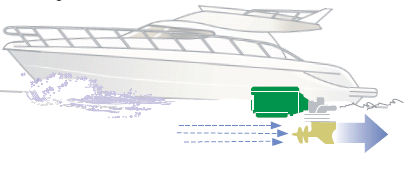New Volvo Penta IPS for Bigger Boats
Recently Volvo Penta announced that it had delivered the 10,000th IPS system to the marine industry world-wide.
That means almost 5,000 boats have been powered by the system. The first IPS systems
introduced a few years ago were limited pretty much to boats in the 33’ to 45’ range
with twin installations. A few builders on both sides of the Atlantic put in triples,
and at least one – Lazzara – installed quad IPS 600s. At the Ft. Lauderdale Boat
Show last fall, Lazzara again stole the show, this time introducing its new 92-footer
with quad IPS 900s, which was the first public showing of the new equipment. The
IPS 900 can develop 700-hp at the crankshaft. What boats will the new, larger IPS
units go in, and what kind of performance can be expected?
Ever since the first IPS was introduced three years ago, people have been asking
why Volvo Penta didn’t make the IPS system for bigger boats. The gentle folks at
Volvo just smiled and asked people to be patient. There is more to all of this than
bolting on a compressor and a blower, an intercooler and bigger injectors. It all
takes a lot of engineering and, well, the biggest market was the one they attacked
first, anyway. And that is also where the advantages of the pod drive and the joystick
would be most pronounced. So bigger engines and bigger pod drives had to wait. And,
now they are here.
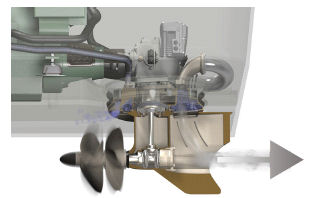 Big boats often have a draft problem with conventional inboards. IPS minimizes draft and its thru-pod exhaust deposits diesel fumes further aft. |
The Second Market
The IPS 800 and IPS 900 10.8 liter diesels develop 600-hp and 700-hp, respectively.
That means, according to Volvo Penta, that they will be appropriate for boats “48’
to 55’+” in twin configuration planning hulls. Yes, companies can install three
or four of the engines in even larger boats, and undoubtedly some will, as shown
by the Lazzara 92.
It is a good time for Volvo Penta to introduce its new larger unit, as it now has
new competition in the pod market from ZF, which first introduced their pods attached
to CMD diesels a couple of years ago and is now licensing Yanmar and Caterpillar,
as well. Currently, the ZF 2500 and 2800 series pods are designed for diesels up
to 450-hp, which mean they will be suitable for boats from about 33’ to 45’.
By jumping up to larger horsepower and larger boats, Volvo Penta continues to lead
the pod drive and joystick technology race.
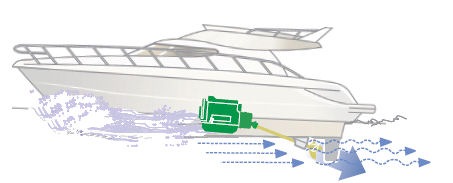 Conventional inboard drives are inherently inefficient because the shaft angle pushes the boat up as well as forward. |
Advantages of Pod Drives
The technology and the benefits of the larger Volvo IPS drives is pretty much the
same as it was for the smaller ones—
*Improved fuel efficiency, higher top speed, greater acceleration, and greater range.
*Low-speed joystick maneuvering.
*Enhanced on-board comfort because of reduced vibration, sound, and exhaust fumes.
*More space for accommodations or engine room equipment.
*One service vender for engine, transmission, and joystick black box.
*Lower emissions.
Volvo Penta is making the same claims about the improvement in fuel efficiency –
a 35% improvement at best cruise -- which they made for the smaller IPS units, vs.
inboard-powered, conventional shaft or V-drive boats. BoatTEST.com has found Volvo’s
claims about fuel efficiency to be generally accurate and, in fact, understated
in the cases we have tested. Volvo claims the top end of their IPS drives is 15%
faster than with conventional inboards, but in tests we have done we have found
that percent of improvement is harder to predict. Certainly it depends on the power
of the engines the IPS system is replacing. Let’s look at a couple of examples…
Doral 45’ Alegria: IPS vs. Inboard
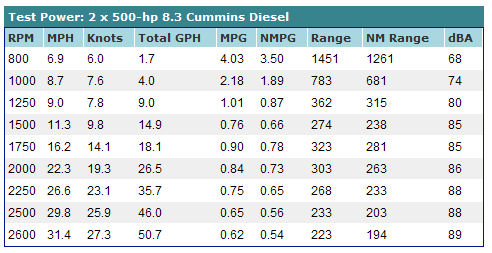 These test numbers are from a 45’ Doral Alegria powered by twin 500-hp CMD 8.3 L diesels with conventional drives. |
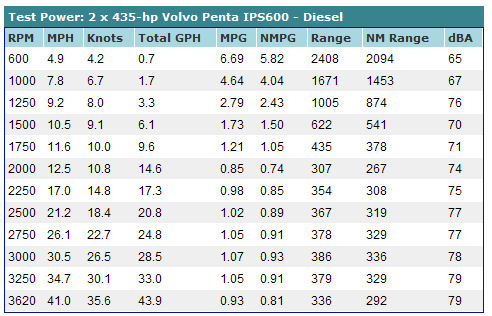 These test numbers are from the 45’ Doral Alegria powered by twin 435-hp IPS diesels. |
As you can see demonstrated in one of the few sistership tests available, the twin
435-hp IPS diesels had a WOT of 41.0 mph vs. 31.4 mph for the twin 500-hp CMD diesels
with conventional drives. That’s a whopping 31% increase in top speed.
Note that the “best cruise” speed of the IPS Doral was 30.5 mph, burning 28.5 gph
and getting 1.07 mpg. The “best cruise” of the conventionally-power Doral was at
1750 rpm going just 16.2 mph, burning 18.1 gph, and getting only .90 mpg. That’s
a 19% improvement in miles per gallon for the IPS-powered boat going twice the speed!
When we look at the inboards’ fuel consumption at the IPS-powered boat’s best cruise
speed, we see that at 2500 rpm (and 29.8 mph), the Doral with conventional diesel
drives burned 46 gph, getting .65 mpg. That means the IPS-powered boat had a 65%
improvement in fuel mileage. This is a huge advantage for people wanting greater
range or lower operating expense.
Formula 45 IPS vs Inboard Test Power:
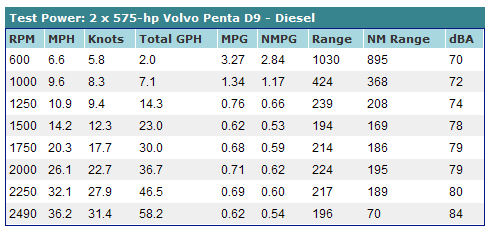 These are the test numbers of a 45’ Formula powered by twin 575-hp Volvo diesels with conventional drives. |
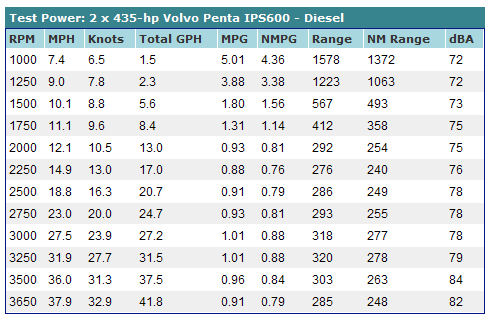 These are the test numbers for a 45’ Formula powered by twin 435-hp IPS diesels. |
When we look at test numbers we have obtained aboard two Formula 45 sisterships
we see that the improvement in top speed is not so dramatic. We recorded an improvement
in WOT of 1.7 mph or 5%. But what is dramatic is the fuel savings per hour with
the IPS at WOT – 39% -- and the increase in miles per gallon of 47%. Of course few
people will operate their 45 Formula at WOT for very long.
But they will drive it at its best cruise for hours at a time. The Formula powered
by the 575-hp conventional inboard Volvo Penta diesels had a best cruise of 26.1
mph, getting .71 mpg. The IPS-powered Formula had a best cruise of 31.9 mph, getting
1.01 miles per gallon. That’s 42% increase in mileage going 22% faster!
Battlewagons and Motoryachts
Heretofore the IPS has been used pretty much exclusively in express cruisers. Now,
with 600-hp and 700-hp diesels connected to beefier IPS pods perhaps the system
can make it an all-new ball game in the larger size boats. Builders of
large convertibles
have been bedeviled for years by customers who want to go 40 knots WOT in their
battlewagons.
Unless you’ve been to a high-stakes big game fishing tournament, you might not understand
it, but there is a lot of swagger on the docks there. Owners are sportsmen who not
only want to catch fish bigger than the guy next to them, they also want to be able
to race him to the fishing grounds and be there first. Sounds silly to a lot of
people, but that’s what makes the world go around.
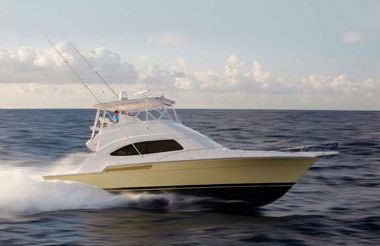 The Bertram 510 might be a good candidate for the new IPS 900. |
The 40-Knot Bar
So, if you are a boat builder, and your new, hot convertible won’t go 40 knots,
you are at a disadvantage. As a result, builders have taken all of the weight they
dare out of the boats, and at least one prohibits extra equipment on its “go-fast”
model, such as a second gen set, to keep the weight down. Then the builders put
huge engines in these boats, and twin 2000-hp diesels are not unusual. Clearly,
with these consumers fuel economy is not much of an issue, nor is the joystick feature,
since most of these boats have captains who pride themselves on precision docking
in tough conditions.
So, that leaves speed and the related issue of weight-to-horsepower as the important
issues. The bobtail Volvo Penta D-11 diesel has the lowest horsepower-to-weight
ratio among the four diesel engine brands and six models we checked. The Cat C-18
(18.1L, 1,000-hp), 3406E (14.6L, 800-hp) and the MTU series 60 (14.0L, 825-hp) were
by far the heaviest, having ratios of 3.29, 3.78, and 3.44 lbs. per horsepower,
respectively.
The MAN V8 and V10 were down in the range of Volvo Penta’s D-11 weight-to-horsepower
ratio, but still slightly heavier at 1.78 and 1.68 lbs. per horsepower, respectively.
The D-11 has the most advantageous ratio among these engines at 1.61 lbs. per horsepower.
That gives the D-11s a huge advantage over the Cats and MTUs and possibly a slight
advantage over the MANs
right from the start, without the addition of the IPS diesel
“giant killer.”
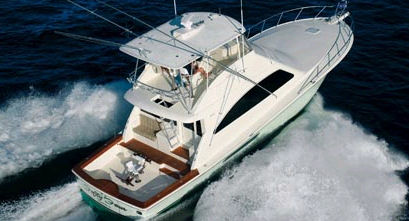 The Ocean Yachts 54 would probably be a rocket ship with the IPS 900s. |
Will Convertibles Switch?
But will the IPS outperform the conventional drive diesel installations, even those
with a couple of hundred horsepower more? Now the relative merits of the IPS pods
with forward-facing dual props aimed horizontally ahead vs. a conventional inboard
diesel drive with the inevitable down angle pushing the boat up instead of forward,
the drag of the struts, shaft and rudder, and the smaller blade area of one prop,
come into play. We won’t know for sure its improvement in performance until we do some testing.
Certainly Volvo Penta feels that they have a big edge. The company has been experimenting
with a 50’ Riviera convertible for a couple of years in the lower Chesapeake Bay
and out in the Atlantic with the IPS 600s. That system has a low enough profile
that the engines can be placed under the cockpit sole, thus creating an extra cabin
or storage space under the salon.
We don’t know if the inherent efficiencies of the IPS pod can overcome the greater
horsepower of the Cats, MANS and Series 60 MTU mentioned above – all of which are
used as standard engines or options in several 50 to 60-footers we looked at. Once
the convertible builders get up the courage to try them, we will find out if they
can break the 40-knot barrier. Already Rampage, Riviera and Cabo have installed
pod drives in their mid-range express fish boats. The Rampage 34 had a WOT of 41.5
mph powered by 2 x 370-hp IPS 500 diesels. (We have tested the Rampage and nothing
maneuvers as well or as easily when fighting big game.)
Pods on Motoryachts
Builders of semi-displacement motoryachts have been the slowest to embrace the new
pod drive technology. In addition to Lazzara, both Grand Banks and Sabre are offering
boats with pod drives; however mainline motoryacht builders such as Hatteras, Princess,
Ferretti and others have yet to offer motoryachts powered by IPS.
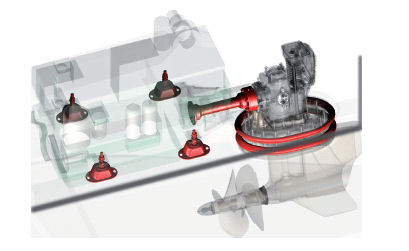 Volvo claims that its IPS system is quieter and transmits less vibration because of the doughnut “O” rings that connect the drive to the hull. |
When we looked at the specs for the Pacific Mariner 65, we thought it might be an
ideal candidate for twin IPS 900s, because the boat is relatively light and has
power options of 800 and 825-hp with Cats and MTU. The IPS’s lighter weight plus
its lower unit advantages should make the Pacific Mariner a logical application.
Other planing motoryachts in the 55’ range should also be candidates if the owners want higher speed and longer range or both. Volvo is not pushing the IPS for displacement-speed
motoryachts, but we suspect it should have fuel economy advantages there, although
probably not so dramatic as with planing boats.
We’ll keep you posted as bigger boats adopt the new power packages. For more information about the new Volvo Penta IPS systems…



